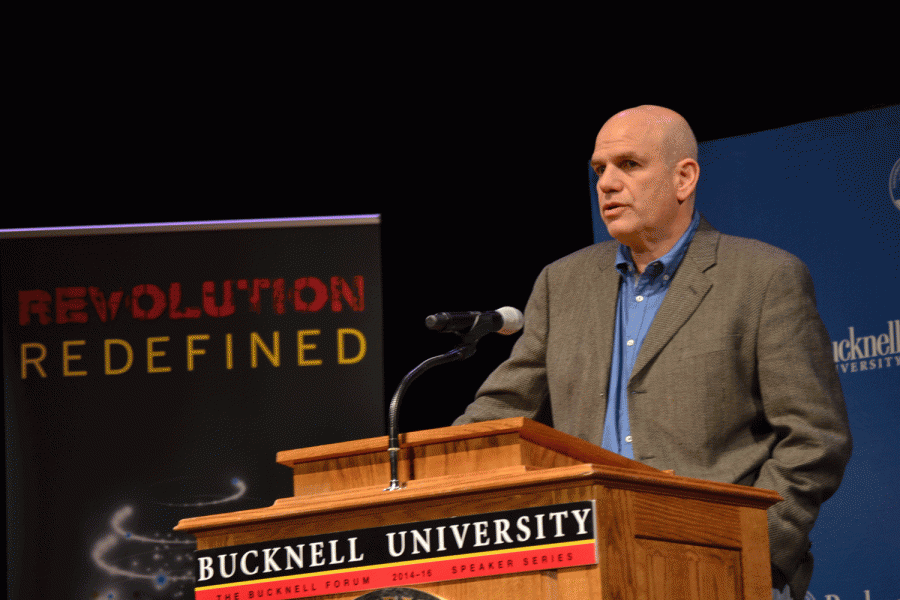Creator of “The Wire”analyzes a divided America
February 26, 2016
David Simon, creator of critically-acclaimed shows like “The Wire,” “Treme,” and “Show Me a Hero,” visited the University on Feb. 18 as part of the Bucknell Forum series. Simon spoke about how his work as a screenwriter, journalist, and author intersects with national issues like race, class, and politics.
Though Simon has led a lauded career as a television screenwriter and producer, his trajectory to fame was far from planned.
“I got in [the entertainment industry] by accident. I really wanted to be a journalist; I was trained to be a journalist. I was a newspaperman for about 15 years,” Simon said.
Following the release and critical and commercial success of his first book, “Homicide: A Year on the Killing Streets,” Simon was asked to write a television pilot based on the novel. Though he said that he began writing the scripts for the NBC series, “Homicide: Life on the Street” with an indifferent attitude, “not seeing it as a career in any sense,” Simon gradually began writing more and more scripts for homicide and cop shows. At the same time, newspaper industries around the country were cutting back on reporters to minimize the industry and make it more profitable.
Simon originally planned to join the staff of the Washington Post following the completion of his second book, “The Corner: A Year in the Life of an Inner-City Neighborhood.” After observing the dark material HBO was willing to air on its network, he envisioned creating a series based on the book he had just completed. This series would become “The Wire.”
“At some point I looked up, and I had been a television writer for longer than I’d been a newspaperman. And I realized, ‘Oh my God, I never went back,’” Simon said.
“The Wire,” arguably Simon’s most notable project thus far, has been regarded as one of the greatest dramas on television by numerous critics. The series captures many of Baltimore’s facets, including street-level drug deals, the pulsation of politics through the city, and failing education systems that are seemingly incapable of reform.
When Simon first started writing for the Baltimore Sun, he said that he arrived with “all the sophistication of a white kid in Montgomery County.” The writer enjoyed how the city represented “a wonderfully rough and tumble place where everybody was different,” and said that he became very attentive to how people talked. Though he had to learn a great deal in adapting from journalism and novelistic writing to typing up scripts for television, Simon took pride in the fact that his dialogue was never “stilted.”
Simon’s job as a police reporter in Baltimore made him understand how the city was deeply impoverished, highly uneducated, and struggling heavily with drug addiction.
“I saw drugs screw up a lot of people’s lives in Baltimore. I’d been at the Sun for about eight to nine years before I realized that drug prohibition is extremely impractical. The police would just barter away the drug culture in favor of solving other cases, creating a cultural warfare,” Simon said.
This war between society and police seems to have begun with what Simon called the town’s militarization. SWAT teams would take down doors, and those loitering in a drug-free zone ran the risk of being arrested. Simon asserted how this aggressive change in law enforcement fostered serious distrust between the police and the community.
“All of the quotes in my articles, at the beginning, seemed to have the phrase ‘police said’ in them,” Simon said. “The police seem to have a monopoly on the information that’s dispersed in [Baltimore].”
Simon emphasized the idea of a “split America”: a country divided by those involved in (or suspected of being involved in) the drug war—the lower class—and those combating it—policemen. Why do certain people choose to make a business out of selling illicit substances? They can’t find employment anywhere else, Simon said, adding that “[t]he drug trade was the only solid employer left in Baltimore, the second being Johns Hopkins University.”
In Simon’s view, tensions between the poor and the law enforcement escalated due to drugs and harsh treatment. Allegedly, police would arrest individuals out of pure suspicion: people who happened to be in a drug-free zone, those sitting on their front stoops, teachers, retirees, and even Simon’s first assistant director, Anthony Hemingway.
“There was a generation of cops that didn’t know how to do actual police work. They’d frisk people for vials. They didn’t know how to write cases, how to find and arrest the right person, or how to write a search warrant,” Simon said.
There were 110,000 arrests made in one year. Many of those arrested would return home that same day without any problems. The police would make them sign a form, promising that they wouldn’t sue on the basis of this false arrest. If the detained individual refused to sign the form, they’d go to court or the process would continue.
“They’d grab the guy that had the vials, but leave another guy who’d just shot a person on the street in the middle of the day,” Simon said.
What is Simon’s final opinion on the matter? Any type of non-violent drug offense shouldn’t be condemning. This begs the question: to what extent should the law get involved with those who either possess or distribute drugs? Simon believes individuals should stop spending money on jailing those who don’t deserve it. He proposes that the layer of warfare associated with prison must be removed and some sort of grudging trust between law enforcement and community must be established.





















